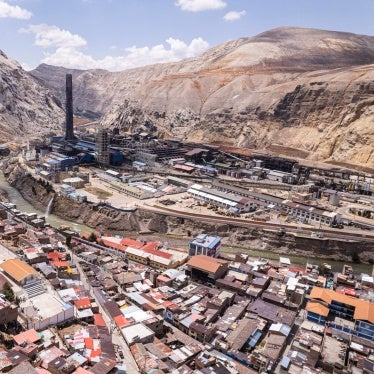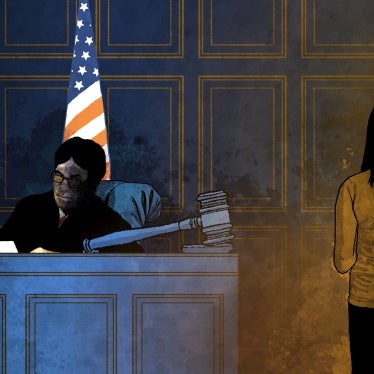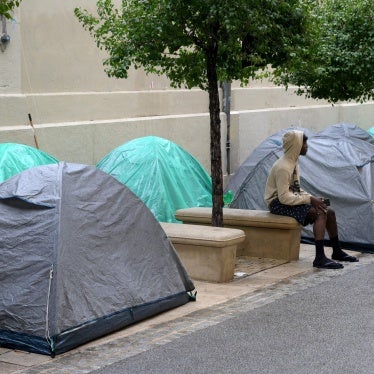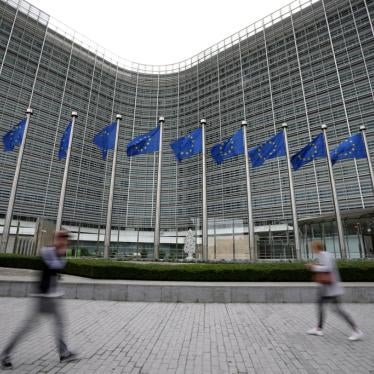Submission to the Committee on the Rights of the Child regarding Children’s Rights and Alternative Care
June 30, 2021
Human Rights Watch welcomes the opportunity to provide input to the Committee on the Rights of the Child ahead of its upcoming Day of General Discussion regarding children’s rights and alternative care.
Detention of Migrant Children
Asylum-seeking and other migrant children, including those with disabilities, may face detention, sometimes for prolonged periods, and other forms of abuse or neglect.
In Greece, unaccompanied migrant children are often placed under “protective custody” in police stations and detention centers, purportedly for their own protection, until they are placed in a shelter.[1] International human rights standards state that immigration-related detention, even for short periods, is never in the best interest of the child and should be prevented due to its harmful impacts.[2] “Protective custody” was initially implemented as a short-term protection measure, but the absence of alternative, acceptable accommodations led to the prolonged detention of children in large detention centers unfit for children.
In 2016, Human Rights Watch spoke to detained children who said the facilities were unsanitary, overcrowded, and had dirty blankets and bugs.[3] Human Rights Watch observed children in facilities who appeared to be experiencing psychological distress and two who had attempted to harm themselves. Many of the children said they did not receive information about their rights or about the process for seeking asylum, nor did they have access to an interpreter.[4]
In November 2020, the government ended the long-standing practice of protective custody, although government data from June 2021 show that some children remain listed as under protective custody.[5]
In the United States, migrant children have been deprived of their right to seek asylum at US borders. A March 2020 order by the Centers for Disease Control and Prevention has allowed border protection agents to conduct more than 845,000 summary expulsions between October 2020 and May 2021, without due process.[6] The US government has not provided a detailed breakdown of how many children it has expelled, but reports from lawyers and others working at the US-Mexico border suggest that many children have been subjected to this summary procedure. In February 2021, the administration of US President Joe Biden directed immigration authorities not to expel unaccompanied children.[7]
These summary expulsions have contributed to many unaccompanied children living in crowded camps and shelters during the Covid-19 pandemic. An inspection by Mexico’s National Human Rights Commission of six detention facilities revealed that that children were held in detention centers and on buses without electricity, water, or natural light.[8] At detention facilities in the US, immigration authorities often separated young children from their families.[9] In addition, Human Rights Watch researchers spoke to asylum seekers, including children, at border towns and along the migrant route in Mexico, who described being sexually assaulted, abducted for ransom, robbed at gunpoint, and being subjected to other crimes.[10]
In Canada in November 2017, government agencies issued directives that require the best interests of the child to be a primary consideration in detention-related decisions and emphasized the need to uphold family unity.[11] Nevertheless, in June 2021, Human Rights Watch reported that children (regardless of their citizenship status) continue to be separated from their detained parents or detained in order to avoid separation.[12] In fact, instead of pursuing alternatives for detained parents, in many cases, authorities have argued that the best interests of the child require keeping children with their parents in detention or separating children from their parents.[13] Some children are also at risk of being transferred to child welfare authorities. Canadian laws do not prescribe a limit to the length of immigration detention, including for children.[14]
Detention facilities in Canada are inadequate and unsuitable for children and families. They resemble medium-security prisons. Children are subject to constant surveillance, are deprived of their privacy, given limited access to medical care and mental health services, and receive inadequate education and poor nutrition. The facilities’ strict rules and daily routines limit children’s participation in recreational activities to those that are primarily sedentary, restrict their mobility, do not allow them to access outdoor spaces, and limit opportunities to socialize with peers.[15]
Key recommendations to States:
- End all immigration detention of children, including in police cells, and develop and use non-custodial measures for unaccompanied children and families with children. Repeal legal provisions and reverse policies under which children may be detained in “protective custody;”
- Place unaccompanied children with members of their families or with host families able and willing to care for them. Children who cannot be placed with families should receive appropriate care and protection.
Residential Institutions
Approximately five to six million children are estimated to live in institutions worldwide.[16] Children with disabilities are at particular risk of institutionalization. For example, according to Serbian government data, in 2019, 73.9 percent of children in institutions were children with disabilities.[17] They enter residential facilities as children where they often remain until adulthood, or for their entire lives.[18]
Human Rights Watch has documented abuses against children, including children with disabilities, in institutions in Armenia, Brazil, Kazakhstan, Kyrgyzstan, Russia, and Serbia.[19]
In all of these countries, children with disabilities often live in large residential institutions, and can experience segregation, neglect, physical and emotional abuse, physical and chemical restraints, potentially inappropriate medical treatment, lack of access to education, lack of privacy, and denial of legal capacity upon reaching childhood, among other abuses.[20] In Kazakhstan, Human Rights Watch documented how staff in one large institution forced older children to work, including mopping floors or taking care of younger children with high support needs.[21]
In Brazil, data from the National Secretariat of Social Assistance shows that there were 5,559 children with disabilities in institutions in 2019.[22] The number is likely higher as the data is self-reported by institutions. Institutions in Brazil are overwhelmingly privately run. Institutions often serve as the only viable housing option for children with disabilities due to insufficient community-based services and support to families.[23] The government’s monthly social assistance benefit to families of children with disabilities is not sufficient for families to raise their children at home.
In addition to the abuses identified above, Human Rights Watch found that staff of some institutions in Brazil undermined children’s dignity by forcing them to share clothes and providing diapers rather than sanitary pads to girls to manage their menstrual hygiene.[24]
Key Recommendations to States:
- Establish a time-bound plan to end the use of institutions of any size for children, including children with disabilities. Deter placement of children in residential institutions and ensure that children are not separated from families due to poverty, other material deprivation, or disability;
- Pending the end of institutionalization, end abuse and neglect in institutions and ensure children’s dignity and rights to food, education, healthcare, play and recreation, and freedom from physical and chemical restraints.
- Ensure accessible and effective mechanisms for children in institutions to report abuse without risk of repercussions;
- Guarantee that national deinstitutionalization plans include children with disabilities, and do not discriminate against children on the basis of disability, on the type of disability or level of support needs;
- Ensure that financial and other resources allocated to institutions are redirected to community-based services and support to families and children, including those with disabilities;
- Collect data on children in institutions including on the number of children, disaggregated by disability-type and other markers. Ensure mechanisms for data sharing between different government agencies; and
- Ensure that national laws on rights of children are fully compliant with both the CRC and CRPD.
Promising Practices
Family Outreach Service
In Serbia, Human Rights Watch reported on the “Family Outreach Service,” developed by UNICEF in cooperation with the Ministry of Employment, Labour, Veteran and Social Policy, which provided support to families that are in risk of child separation, including families with children with disabilities.[25] Due to insufficient funding, the service ended in 2018. At the time of writing, there is some reporting that the program may be reinstituted.
Eight full-time and eight part-time family outreach workers would visit families and provide support. This included counseling, advocating with different agencies for the rights of the child and the family, assisting with documentation necessary for families to receive financial support, obtain health care, and enroll children in day care and schools. The state agency for social welfare prioritized services for families who needed it the most.
Deinstitutionalization
In 2016 and 2017, Human Rights Watch conducted research in institutions for children in Armenia and has followed the deinstitutionalization process there.[26] In recent years, the government has undertaken initiatives to reunite children in residential institutions with their families, reform and expand the foster care system, and transform or phase out the use of residential institutions. Historically, there have been three types: night boarding institutions, residential schools for children with disabilities, and orphanages.
Night boarding institutions, which housed and fed children experiencing poverty or other difficult circumstances, have been closed, with five transformed to community support centers that include temporary crisis shelters for children.[27] The government has closed at least 14 residential schools for children with disabilities and one orphanage. There is no data on how many children were moved to other residential institutions in this process, although past transformation of institutions resulted in reinstitutionalization of some children.
Three orphanages for children with disabilities have not been included in the government’s deinstitutionalization plans.[28] Two general orphanages – that house 570 children, of whom 450 have disabilities – also remain.[29] An unknown number of private orphanages also exist, with minimal oversight from the government.
Seven residential special schools remain, all of which are in the capital, Yerevan, except for one. According to UNICEF, there are plans to transform the remaining special schools into resource centers to provide guidance, training, and educational resources to schools across the country that would support children with disabilities to remain in their communities and attend mainstream schools.[30]
Legal and financial reforms have expanded foster care, with 88 children currently in foster care (one to two children have disabilities), an approximate three-fold increase from 2016.[31]
As part of the deinstitutionalization process, the Armenian government and non-governmental organizations have provided some short-term material support packages to children reunited with their families. In 2018 and 2019, World Vision Armenia, along with support from the government, provided 1,500 cows to promote financial stability amongst families whose children returned home from institutions or who were at risk of institutionalization due to poverty
[1] Human Rights Watch, “Ending Child Detention in Greece is Possible,” Human Rights Watch news release, August 4, 2020, https://www.hrw.org/news/2020/08/04/ending-child-detention-greece-possible.
[3] Human Rights Watch, “Greece: Migrant Children in Police Cells,” Human Rights Watch news release, July 19, 2016, https://www.hrw.org/news/2016/07/19/greece-migrant-children-police-cells.
[4] Human Rights Watch, “Greece: Migrant Children in Police Cells,” Human Rights Watch news release, July 19, 2016, https://www.hrw.org/news/2016/07/19/greece-migrant-children-police-cells.
[5] Ibid. See also: “Greece Commits to End ‘Protective’ Child Detention,” Human Rights Watch news release, November 19, 2020, https://www.hrw.org/news/2020/11/19/greece-commits-end-protective-child-detention; E.K.K.A. – National Center for Social Solidarity, “Situation Update: Unaccompanied Children (UAC) in Greece,” June 15, 2021, https://www.ekka.org.gr/images/KOINONIKON-PAREMBASEON/%CE%A3%CE%A4%CE%91%CE%A4%CE%99%CE%A3%CE%A4%CE%99%CE%9A%CE%91_2021/EKKA_Dashboard_20210615.pdf
[6] Eileen Sullivan and Zolan Kanno-Youngs, “Biden Officials Consider Phasing Out Rule That Blocked Migrants During Pandemic,” June 24, 2021, https://www.nytimes.com/2021/06/24/us/politics/biden-title-42-migrants-coronavirus.html; U.S. Customs and Border Protection, “Nationwide Enforcement Encounters: Title 8 Enforcement Actions and Title 42 Expulsions,” June 9, 2021, https://www.cbp.gov/newsroom/stats/cbp-enforcement-statistics/title-8-and-title-42-statistics.
[7] Julia Neusner, “‘They Lied to Us’”: Biden Administration Continues to Expel, Mistreat Families Seeking Asylum, May 13, 2021, https://www.humanrightsfirst.org/blog/they-lied-us-biden-administration-continues-expel-mistreat-families-seeking-asylum. On June 24, media outlets reported the US would lift the public health bar on family groups. Eileen Sullivan and Zolan Kanno-Youngs, “Biden Officials Consider Phasing Out Rule That Blocked Migrants During Pandemic.”
[8] Tyler Mattiace, “Mexico Cannot Solve the U.S. Border Crisis,” May 23, 2021, https://www.dallasnews.com/opinion/commentary/2021/05/23/mexico-cannot-solve-the-us-border-crisis/.
[9] Human Rights First, “Deliver to Danger,” February 19, 2021, https://www.humanrightsfirst.org/campaign/remain-mexico.
[10] Clara Long (Human Rights Watch), “More Action is Needed to End Family Separations and Protect Children at the Border” commentary, The Hill, February 13, 2021, https://www.hrw.org/news/2021/02/13/more-action-needed-end-family-separations-and-protect-children-border.
[11] Human Rights Watch, “Joint Submission to the Committee on the Rights of the Child’s Review of Canada,” March 4, 2020, https://www.hrw.org/news/2020/03/04/joint-submission-committee-rights-childs-review-canada.
[12] Ibid., I Didn’t Feel Like a Human in There: Immigration Detention in Canada and its Impact on Mental Health (New York: Human Rights Watch, 2021), https://www.hrw.org/report/2021/06/17/i-didnt-feel-human-there/immigration-detention-canada-and-its-impact-mental.
[13] Ibid. See also: Human Rights Watch, “Joint Submission to the Committee on the Rights of the Child’s Review of Canada.”
[14] Ibid.
[15] Ibid.
[16] Philip S Goldman et al., “Institutionalisation and Deinstitutionalisation of Children 2: Policy and Practice Recommendations for Global, National, and Local Actors,” The Lancet: Child & Adolescent Health, vol. 4 (8), https://www.thelancet.com/journals/lanchi/article/PIIS2352-4642(20)30060-2/fulltext, pp. 606-633.
[17] Republic Institute for Social Protection, “Children in the system of social protection, 2019,” http://www.zavodsz.gov.rs/media/2000/deca-u-sistemu-socijalne-zastite-2019.pdf.
[18] Human Rights Watch, They Stay until They Die: A Lifetime of Isolation and Neglect in Institutions for People with Disabilities in Brazil (New York: Human Rights Watch, 2018), https://www.hrw.org/report/2018/05/23/they-stay-until-they-die/lifetime-isolation-and-neglect-institutions-people.
[19] To view the relevant research, please see: Human Rights Watch, When Will I Get to Go Home?: Abuses and Discrimination against Children in Institutions and Lack of Access to Quality Inclusive Education in Armenia (New York: Human Rights Watch, 2017), https://www.hrw.org/report/2017/02/22/when-will-i-get-go-home/abuses-and-discrimination-against-children-institutions; They Stay until They Die: A Lifetime of Isolation and Neglect in Institutions for People with Disabilities in Brazil (New York: Human Rights Watch, 2018); On the Margins: Education for Children with Disabilities in Kazakhstan (New York: Human Rights Watch, 2019), https://www.hrw.org/report/2019/03/14/margins/education-children-disabilities-kazakhstan; “Kazakhstan: Children in Institutions Isolated, Abused,” Human Rights Watch news release, July 17, 2019, https://www.hrw.org/news/2019/07/17/kazakhstan-children-institutions-isolated-abused; Insisting on Inclusion: Institutionalization and Barriers to Education for Children with Disabilities in Kyrgyzstan (New York: Human Rights Watch, 2020), https://www.hrw.org/report/2020/12/10/insisting-inclusion/institutionalization-and-barriers-education-children; Abandoned by the State: Violence, Neglect, and Isolation for Children with Disabilities in Russian Orphanages (New York: Human Rights Watch, 2014), https://www.hrw.org/report/2014/09/15/abandoned-state/violence-neglect-and-isolation-children-disabilities-russian; It is My Dream to Leave This Place: Children with Disabilities in Serbian Institutions (New York: Human Rights Watch, 2016), https://www.hrw.org/report/2016/06/08/it-my-dream-leave-place/children-disabilities-serbian-institutions.
[20] Ibid.
[21] Human Rights Watch, “Kazakhstan: Children in Institutions Isolated, Abused.”
[22] Human Rights Watch, They Stay until They Die: A Lifetime of Isolation and Neglect in Institutions for People with Disabilities in Brazil. (New York: Human Rights Watch, 2018), https://www.hrw.org/report/2018/05/23/they-stay-until-they-die/lifetime-isolation-and-neglect-institutions-people.
[23] Ibid.
[24] Ibid.
[25] Human Rights Watch, It is My Dream to Leave This Place: Children with Disabilities in Serbian Institutions (New York: Human Rights Watch, 2016), https://www.hrw.org/report/2016/06/08/it-my-dream-leave-place/children-disabilities-serbian-institutions.
[26] Human Rights Watch, When Will I Get to Go Home?: Abuses and Discrimination against Children in Institutions and Lack of Access to Quality Inclusive Education in Armenia (New York: Human Rights Watch, 2017), https://www.hrw.org/report/2017/02/22/when-will-i-get-go-home/abuses-and-discrimination-against-children-institutions.
[27] The five-night boarding institutions that have been transformed to community support centers are located in Gyumri, Kapan, Lori, Yerevan, and Zatik.
[28] The three orphanages for children with disabilities which have not been included in the government’s deinstitutionalization plans are the Mariz Izmirlyan, Kharberd, and Gyumri specialized orphanages.
[29] The two general orphanages are located in Gavar and Yerevan.
[30] Human Rights Watch telephone interview with a representative from UNICEF, June 15, 2021.
[31] Facebook post of the Ministry of Labor and Social Affairs of Armenia, https://www.facebook.com/1639975722781788/posts/3955593041220033/?d=n.







